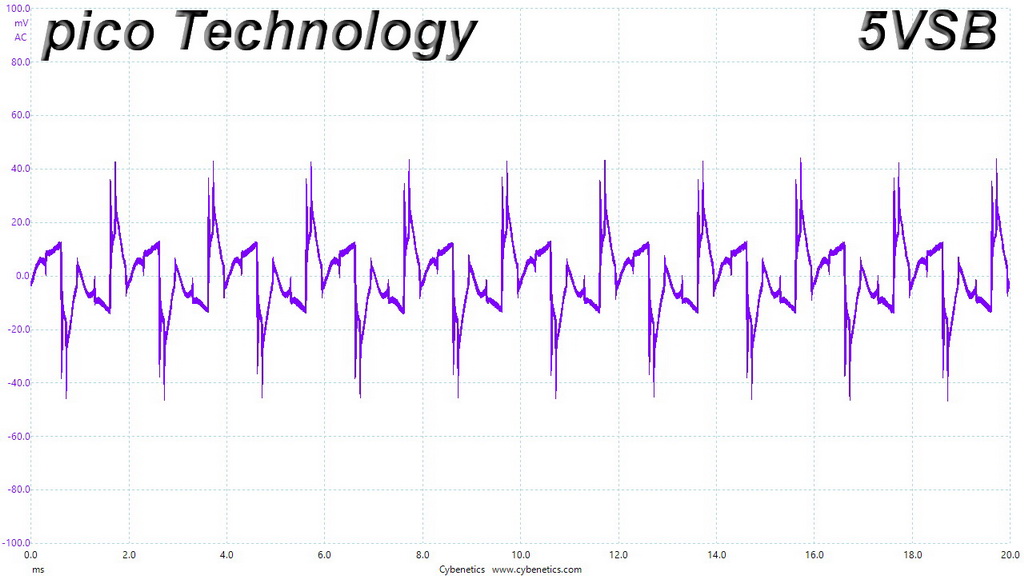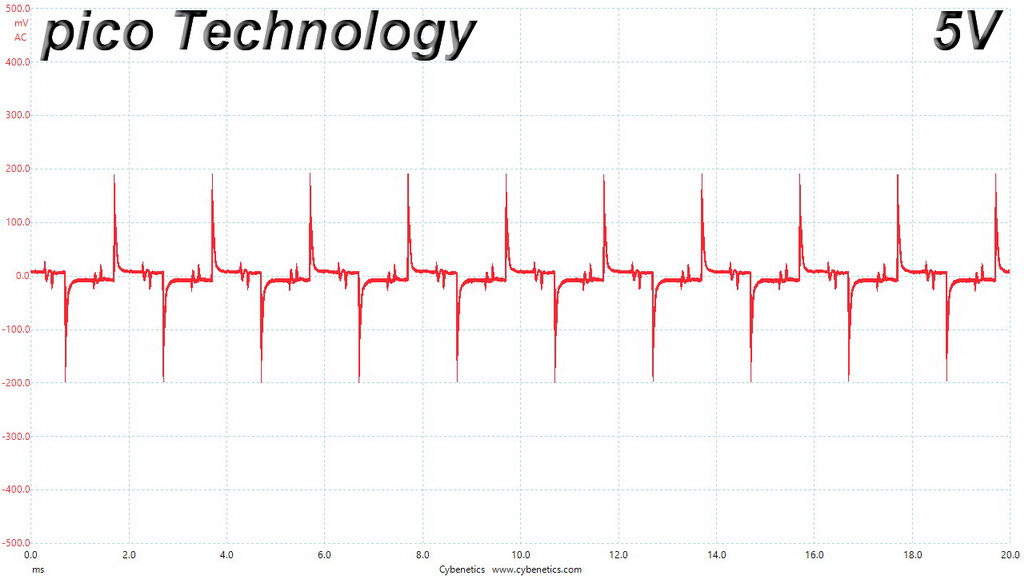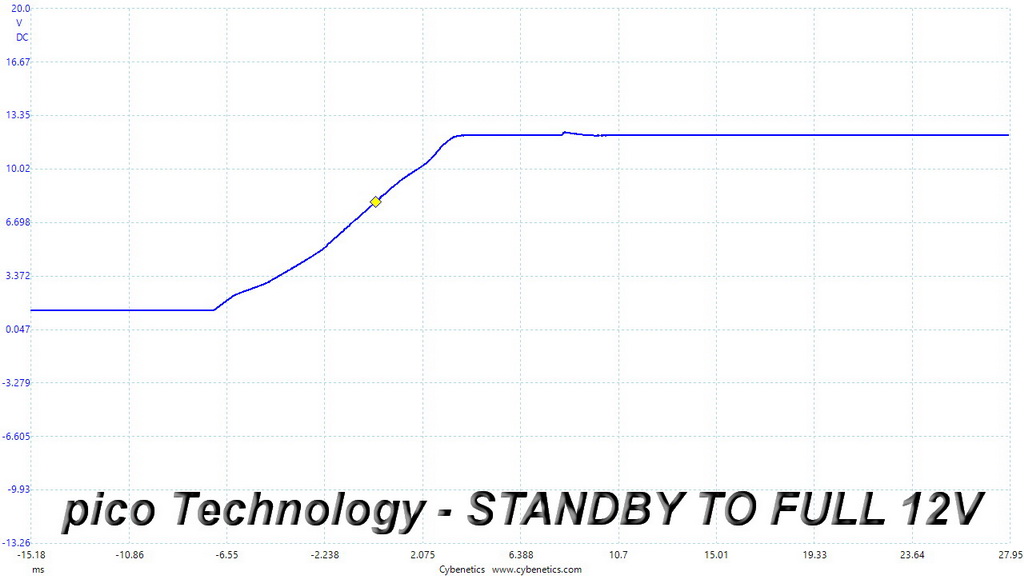Seasonic Focus Plus Gold 850 PSU Review
Why you can trust Tom's Hardware
Transient Response Tests
Advanced Transient Response Tests
For details on our transient response testing, please click here.
Ιn these tests, we monitor the SSR-850FX's response in several scenarios. First, a transient load (10A at +12V, 5A at 5V, 5A at 3.3V, and 0.5A at 5VSB) is applied for 200ms as the PSU works at 20 percent load. In the second scenario, it's hit by the same transient load while operating at 50 percent load.
In the next sets of tests, we increase the transient load on the major rails with a new configuration: 15A at +12V, 6A at 5V, 6A at 3.3V, and 0.5A at 5VSB. We also increase the load-changing repetition rate from 5 Hz (200ms) to 50 Hz (20ms). Again, this runs with the PSU operating at 20 and 50 percent load.
The last tests are even tougher. Although we keep the same loads, the load-changing repetition rate rises to 1 kHz (1ms).
In all of the tests, we use an oscilloscope to measure the voltage drops caused by the transient load. The voltages should remain within the ATX specification's regulation limits.
These tests are crucial because they simulate the transient loads a PSU is likely to handle (such as booting a RAID array or an instant 100 percent load of CPU/GPUs). We call these "Advanced Transient Response Tests," and they are designed to be very tough to master, especially for a PSU with a capacity of less than 500W.
Advanced Transient Response at 20 Percent – 200ms
| Voltage | Before | After | Change | Pass/Fail |
|---|---|---|---|---|
| 12V | 12.142V | 12.077V | 0.54% | Pass |
| 5V | 5.009V | 4.855V | 3.07% | Pass |
| 3.3V | 3.325V | 3.183V | 4.27% | Pass |
| 5VSB | 5.068V | 5.017V | 1.01% | Pass |
Advanced Transient Response at 20 Percent – 20ms
| Voltage | Before | After | Change | Pass/Fail |
|---|---|---|---|---|
| 12V | 12.141V | 12.043V | 0.81% | Pass |
| 5V | 5.008V | 4.822V | 3.71% | Pass |
| 3.3V | 3.325V | 3.146V | 5.38% | Pass |
| 5VSB | 5.068V | 5.027V | 0.81% | Pass |
Advanced Transient Response at 20 Percent – 1ms
| Voltage | Before | After | Change | Pass/Fail |
|---|---|---|---|---|
| 12V | 12.140V | 12.052V | 0.72% | Pass |
| 5V | 5.008V | 4.821V | 3.73% | Pass |
| 3.3V | 3.325V | 3.145V | 5.41% | Pass |
| 5VSB | 5.069V | 5.022V | 0.93% | Pass |
Advanced Transient Response at 50 Percent – 200ms
| Voltage | Before | After | Change | Pass/Fail |
|---|---|---|---|---|
| 12V | 12.139V | 12.079V | 0.49% | Pass |
| 5V | 5.006V | 4.840V | 3.32% | Pass |
| 3.3V | 3.321V | 3.163V | 4.76% | Pass |
| 5VSB | 5.040V | 4.991V | 0.97% | Pass |
Advanced Transient Response at 50 Percent – 20ms
| Voltage | Before | After | Change | Pass/Fail |
|---|---|---|---|---|
| 12V | 12.138V | 12.052V | 0.71% | Pass |
| 5V | 5.005V | 4.805V | 4.00% | Pass |
| 3.3V | 3.321V | 3.151V | 5.12% | Pass |
| 5VSB | 5.040V | 4.987V | 1.05% | Pass |
Advanced Transient Response at 50 Percent – 1ms
| Voltage | Before | After | Change | Pass/Fail |
|---|---|---|---|---|
| 12V | 12.139V | 12.054V | 0.70% | Pass |
| 5V | 5.006V | 4.806V | 4.00% | Pass |
| 3.3V | 3.321V | 3.130V | 5.75% | Fail |
| 5VSB | 5.040V | 4.992V | 0.95% | Pass |





The 12V rail performs well. So does the 5VSB rail, even if it won't have to deal with significant transient loads in real life scenarios.
Get Tom's Hardware's best news and in-depth reviews, straight to your inbox.
Both minor rails (5V and 3.3V) register large deviations. In fact, the 3.3V rail fails one of our tests. As it seems that transient loads are the minor rails' weak point, the only comfort is that they similarly won't have to endure loads like the ones we subjected them to in an actual PC (under normal conditions, at least).
Here are the oscilloscope screenshots we took during Advanced Transient Response Testing:
Transient Response At 20 Percent Load – 200ms




Transient Response At 20 Percent Load – 20ms




Transient Response At 20 Percent Load – 1ms




Transient Response At 50 Percent Load – 200ms




Transient Response At 50 Percent Load – 20ms




Transient Response At 50 Percent Load – 1ms




Turn-On Transient Tests
In the next set of tests, we measured the SSR-850FX's response in simpler transient load scenarios—during its power-on phase.
For our first measurement, we turned the SSR-850FX off, dialed in the maximum current the 5VSB rail could output, and switched the PSU back on. In the second test, we dialed the maximum load the +12V rail could handle and started the 850W supply while it was in standby mode. In the last test, while the PSU was completely switched off (we cut off the power or switched the PSU off), we dialed the maximum load the +12V rail could handle before switching it back on from the loader and restoring power. The ATX specification states that recorded spikes on all rails should not exceed 10 percent of their nominal values (+10 percent for 12V is 13.2V, and 5.5 V for 5V).



All in all, the PSU demonstrates good performance in these tests, with no notable spikes and/or voltage overshoots.
MORE: Best Power Supplies
MORE: How We Test Power Supplies
MORE: All Power Supply Content
Current page: Transient Response Tests
Prev Page Cross-Load Tests & Infrared Images Next Page Ripple Measurements
Aris Mpitziopoulos is a contributing editor at Tom's Hardware, covering PSUs.
-
JohnnyLucky Nice review. I'll add it to the psu recommendation list I maintain.Reply
Last week newegg had the 650 watt model on sale for $74.99. There was a $20.00 mail-in rebate which brought the price down to $54.99. On top of that there was a free $30.00 gift certificate for a fresh food vendor online which my wife wasted no time in using. That brought the final price down to $24.99. Best deal I've taken advantage of this year. -
JohnUSA I just found this model selling for just $74 at SuperBiiz-dot-com, which I think is a great deal.Reply -
buzznut47 This was rated highly by JonnyGuru, and based on that I made a purchase 2 or 3 months ago. I have been mostly happy with its performance. I am running an FX 8320 @3.8 Ghz, 2 R9 280X, custom loop with 8 fans, and a couple of drives.Reply
Initially I was really impressed that there was so much power in such a small package. Until I saw the cables, and the ridiculous capacitors. I know this brings a fantastic level of ripple, but I don't like it at all.
I gotta say, I really don't like this trend with higher end power supplies. As a modder, my cables are visible. And these cables would be satisfactory, if the capacitors were located ON THE PSU SIDE!! But they are located on the component side where they can be seen in all their glorious ugliness. It is not recommended to change the polarity..
I will be checking the units I buy more carefully moving forward. I would much rather have a longer power supply unit that has the caps inside.
Bottom line though, it is a gold 850W unit at an affordable price and a 10 year warranty. For efficient cards like the RX570/580 and GTX 1060, there are enough cables for 6 video cards. Pretty good for mining, but as for a visible gaming rig I have to say 4 out of 5 stars for functionality. Just put the caps at the other end of the cable, ya big dummy. -
berezini Still haven't changed my mind on getting one after killing my new motherboard and couple other components. Just would never recommend seasonic ever again.Reply -
ZRace Great review, looks like this will be my next PSU unless something better releases by the time I need a replacement. Definitely gonna recommend this to others!Reply -
JohnnyLucky ARIS - Are you still here?Reply
The PCIe cables are a little different than what I am used to. The 850 model and my 650 watt version have PCIe cables with two connectors instead of just one at their device end. Does that mean one PCIe cable can be used for both connections on a graphics card? On the other hand do I still have to use two PCIe cables and let one connector on each cable just hang there?
Anybody else know? -
Leaps-from-Shadows Reply
Even the best manufacturers produce the occasional lemon. It's too bad you're one-and-done -- you're really missing out on quite possibly the best power supplies out there.20427267 said:Still haven't changed my mind on getting one after killing my new motherboard and couple other components. Just would never recommend seasonic ever again.
It's okay though ... they will survive without your money. -
Leaps-from-Shadows Reply
You can certainly use the two connectors from a single cable. However, a video from JayzTwoCents showed it was better to use two separate cables.20430290 said:ARIS - Are you still here?
The PCIe cables are a little different than what I am used to. The 850 model and my 650 watt version have PCIe cables with two connectors instead of just one at their device end. Does that mean one PCIe cable can be used for both connections on a graphics card? On the other hand do I still have to use two PCIe cables and let one connector on each cable just hang there?
Anybody else know? -
JohnnyLucky Leaps - Thanks for the info.Reply
I went back and read the review. In the specs it shows 3 PCI-e cables and 6 connectors. It also indicates the 3 cables could be used with 3 video cards, each requiring 2 connectors.
I'll take a look at the video. I've watched some of his other clips.
Don't know how I missed this development.
-
Leaps-from-Shadows Reply
Here it is, in case you couldn't find it...20430533 said:Leaps - Thanks for the info.
I went back and read the review. In the specs it shows 3 PCI-e cables and 6 connectors. It also indicates the 3 cables could be used with 3 video cards, each requiring 2 connectors.
I'll take a look at the video. I've watched some of his other clips.
Don't know how I missed this development.